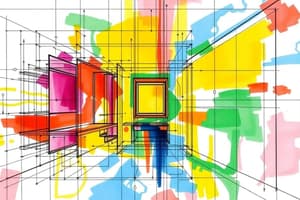Podcast
Questions and Answers
Which type of line represents features that cannot be seen in the current view?
Which type of line represents features that cannot be seen in the current view?
- Visible line
- Dimension line
- Hidden line (correct)
- Center line
Dimensional lines and extension lines serve the same purpose in a drawing.
Dimensional lines and extension lines serve the same purpose in a drawing.
False (B)
What spacing is recommended between words in technical drawing standards?
What spacing is recommended between words in technical drawing standards?
The space required for writing the letter 'O'.
A __________ line is used to represent symmetry and the path of motion.
A __________ line is used to represent symmetry and the path of motion.
Match the following line types with their descriptions:
Match the following line types with their descriptions:
What is the designation of a full-size drawing scale?
What is the designation of a full-size drawing scale?
The dimension numbers shown in a drawing are dependent on the drawing scale used.
The dimension numbers shown in a drawing are dependent on the drawing scale used.
What are the recommended text heights for lettering in drawings?
What are the recommended text heights for lettering in drawings?
The standard reducing scales are ___, ___, ___, ___, ___, and ___.
The standard reducing scales are ___, ___, ___, ___, ___, and ___.
Match the following scaling types to their designations:
Match the following scaling types to their designations:
Which of the following properties is NOT recommended for text style in drawings?
Which of the following properties is NOT recommended for text style in drawings?
What is the ratio that describes a reduction scale?
What is the ratio that describes a reduction scale?
The space between words in drawing lettering should be irregular.
The space between words in drawing lettering should be irregular.
Which of the following is NOT a standard sheet size for technical drawings?
Which of the following is NOT a standard sheet size for technical drawings?
The title block of an engineering drawing includes the dimensions of the object.
The title block of an engineering drawing includes the dimensions of the object.
What does the American National Standard Institute (ANSI) signify in engineering drawing standards?
What does the American National Standard Institute (ANSI) signify in engineering drawing standards?
The standard size for an A4 drawing sheet is ______ x ______ mm.
The standard size for an A4 drawing sheet is ______ x ______ mm.
Match the following components of a drawing with their descriptions:
Match the following components of a drawing with their descriptions:
What is the primary purpose of drawing standards in engineering?
What is the primary purpose of drawing standards in engineering?
Visualization is the ability to mentally picture objects that do not exist.
Visualization is the ability to mentally picture objects that do not exist.
What is the stroke sequence used for standard lettering in engineering drawings?
What is the stroke sequence used for standard lettering in engineering drawings?
Which type of axonometric projection shows all angles as equal?
Which type of axonometric projection shows all angles as equal?
In a cabinet oblique projection, the scale is typically drawn at full size.
In a cabinet oblique projection, the scale is typically drawn at full size.
What are the two angles used in a dimetric axonometric projection?
What are the two angles used in a dimetric axonometric projection?
A __________ projection uses oblique lines that are parallel to the picture plane.
A __________ projection uses oblique lines that are parallel to the picture plane.
Match the following types of oblique projection with their characteristics:
Match the following types of oblique projection with their characteristics:
Which of the following is NOT a type of axonometric projection?
Which of the following is NOT a type of axonometric projection?
Trimetric projections have no angles equal between axes.
Trimetric projections have no angles equal between axes.
What distinguishes an oblique projection from an axonometric projection?
What distinguishes an oblique projection from an axonometric projection?
What is the primary advantage of using isometric drawing for circles?
What is the primary advantage of using isometric drawing for circles?
The longest dimension of an object should be positioned perpendicular to the frontal plane.
The longest dimension of an object should be positioned perpendicular to the frontal plane.
What is the method used to draw isometric ellipses with drawing instruments?
What is the method used to draw isometric ellipses with drawing instruments?
In an oblique sketch, the features of an object are represented at an angle to the __________ plane.
In an oblique sketch, the features of an object are represented at an angle to the __________ plane.
Which of the following steps is NOT part of sketching an isometric ellipse?
Which of the following steps is NOT part of sketching an isometric ellipse?
Match the following types of projections with their characteristics:
Match the following types of projections with their characteristics:
Irregular curves in isometric views are sketched by connecting lines between constructed points.
Irregular curves in isometric views are sketched by connecting lines between constructed points.
What guideline should be followed for placing complex features in a drawing?
What guideline should be followed for placing complex features in a drawing?
What is the purpose of an isometric axis in an isometric sketch?
What is the purpose of an isometric axis in an isometric sketch?
Hidden lines are included in isometric sketches unless absolutely necessary.
Hidden lines are included in isometric sketches unless absolutely necessary.
What angle should be used to rotate the viewpoint about the vertical axis in an isometric projection?
What angle should be used to rotate the viewpoint about the vertical axis in an isometric projection?
In isometric sketching, all edges are foreshortened about ____ time.
In isometric sketching, all edges are foreshortened about ____ time.
Match the following types of isometric axes with their descriptions:
Match the following types of isometric axes with their descriptions:
What is the first step in sketching from an actual object?
What is the first step in sketching from an actual object?
Isometric projections can only present a single view of an object.
Isometric projections can only present a single view of an object.
What should you do after selecting the isometric axis while sketching?
What should you do after selecting the isometric axis while sketching?
Flashcards are hidden until you start studying
Study Notes
Type X (A0~A4)
- Type X refers to the sheet sizes A0 through A4.
- The minimum border width "c" is 10mm for all sizes except A1 and A0, where it is 20mm.
- The minimum border width "d" is 25mm for all sheet sizes.
- The drawing space is the area within the borders.
- The title block should be placed below the drawing space.
Type Y (A4 only)
- Type Y refers to specific drawing requirements for A4 sheet size only.
- The title block is placed below the drawing space.
Drawing Scales : Definition
- Scale is the ratio between the linear dimension of a drawn representation of an object and the actual object.
- Drawing scale is commonly found in the title block.
Drawing Scales : Designation
- Designating a scale consists of the word "SCALE" followed by its ratio.
- For full-size drawings, the scale is "SCALE 1:1”.
- For enlarged drawings, the scale is "SCALE X:1" where X is greater than 1.
- For reduced drawings, the scale is "SCALE 1:X" where X is greater than 1.
Drawing Scales : Notes
- Dimension numbers shown in a drawing represent the true size of an object, independent of the drawing scale used.
Drawing Scales : Standard scales
- Standard reducing scales are: 1:2, 1:5, 1:10, 1:20, 1:50, 1:100
- Standard enlarging scales are: 2:1, 5:1, 10:1, 20:1, 50:1, 100:1
Lettering : Recommendation
- Text on drawings should have uniform shape, size (text height), and thickness of stroke, with appropriate space between letters and words.
Lettering : Style (this course)
- Gothic vertical style.
- Begin the sentence, phrase, or word with a capital letter.
- Text height should be 2-3 mm.
- Spacing between adjacent contours depends on the shape of the letters:
- Straight-straight: II, IN, IM, IP etc.
- Straight-curve (or curve-straight): IO, QR etc.
- Straight-slant (or slant-straight): IV, IW etc.
- Curve-curve: OO, OG etc.
- Slant-curve (or curve-slant): VO, WG, VC etc.
- Slant-slant: VW, VX etc.
- Leave the space between words equal to the space required for writing a letter "O".
Line Types : Basic Line Types & Name according to application
- Visible line: Continuous line, thick. Represents features that can be seen in the current view.
- Hidden line: Dash line, thin. Represents features that cannot be seen in the current view.
- Dimension line: Continuous line, thin. Indicates the sizes and locations of features.
- Extension line: Continuous line, thin. Extends from the object to the dimension line.
- Leader line: Continuous line, thin. Connects a dimension or note to a specific feature.
- Center line: Chain line, thin. Represents symmetry, path of motion, centers of circles, and axis of axisymmetrical parts.
Elements of a Drawing
- Engineering drawings require both graphics and word languages.
- Graphics describe the object's shape primarily.
- Word language describes the exact size, location, and specification of the object.
- Text on drawings includes dimensions, notes, and the title block.
Knowledge and Skills Require : Engineering Drawing
- Graphics language:
- Geometric construction
- Projection method
- Using line types
- Word language:
- Dimensions & Notes
- Visualization
Drawing Sheet : Standard size (JIS)
- Standard sheet sizes are A0, A1, A2, A3, and A4.
- Dimensions are in millimeters:
- A4: 210 x 297
- A3: 297 x 420
- A2: 420 x 594
- A1: 594 x 841
- A0: 841 x 1189
Drawing Sheet : Orientation & Margin
- Orientation refers to the layout of the drawing on the sheet.
- Margin refers to the blank space around the drawing area.
- The sheet should be oriented with the longer side as the vertical direction.
- Margins are used for binding, folding, and leaving space for notes and other information.
Definition and Necessity
- Drawing standards are a set of rules that govern how technical drawings are represented.
- They ensure drawings convey the same meaning to everyone who reads them.
Standard Code
- Different countries have different standard codes:
- USA: ANSI (American National Standard Institute)
- Japan: JIS (Japanese Industrial Standard)
- UK: BS (British Standard)
- Australia: AS (Australian Standard)
- Germany: DIN (Deutsches Institut für Normung)
- International: ISO (International Standards Organization)
Pictorial Projection
- Pictorial projections are used to represent three-dimensional objects on a two-dimensional plane.
- Two main types: Axonometric and Oblique projections.
- Axonometric projection: parallel lines of sight are normal to the picture plane.
- Oblique projection: parallel lines of sight are oblique (not normal) to the picture plane.
Axonometric Projection
- All parallel lines in space remain parallel in the projection.
- The projection is determined by the angle between the line of sight and the picture plane.
Types of Axonometric Projection
- Isometric: All three angles are equal.
- Dimetric: Two of the three angles are equal.
- Trimetric: All three angles are unequal.
Oblique Projection
- Oblique drawing angle is the angle between the line of sight and the picture plane.
- Two main types: Cavalier and Cabinet.
- Cavalier: full scale in all directions.
- Cabinet: full scale in one direction, half scale in the other.
Isometric Projection
- Regular isometric: View point is looking down on the top of the object.
- Reverse isometric: View point is looking up on the bottom of the object.
- Long axis isometric: View point is looking from the right (or left) of the object.
- Isometric lines are parallel to any of the isometric axes.
- Nonisometric lines are not parallel to any of the isometric axes.
- In an isometric drawing, a circle appears as an ellipse.
- Isometric drawings are used for a variety of purposes, including technical drawings, architectural plans, and product design.
Isometric Sketching
- Sketch from an actual object: Place the object in a position where its shape and features are visible. Define an isometric axis. Sketch the enclosing box (or cylinder). Estimate the size and relationship of each detail. Darken all visible lines.
- Sketch from a multiview drawing: Interpret the meaning of lines/areas in the multiview drawing. Locate the lines or surfaces relative to the isometric axis.
- Hidden lines in isometric sketches/drawings are omitted unless absolutely necessary.
Oblique Sketching
- Complex features are placed parallel to the frontal plane.
- The longest dimension of an object should be parallel to the frontal plane.
Orientation of Isometric Axes
- Isometric axes can be arbitrarily oriented to create different views of a single object.
Distance in Isometric Sketch
- True-length distances are shown along isometric lines.
Isometric Projection vs. Isometric Drawing
- Isometric projection (true projection): the projection is a true representation of the object, but it is not full scale.
- Isometric drawing (full size): it is a full-scale representation of the object, but it is not a true projection.
- Isometric drawing is a full-size, full-scale representation of an object, but it is not a true projection.
- Isometric projection is a scaled representation of an object.
Studying That Suits You
Use AI to generate personalized quizzes and flashcards to suit your learning preferences.




